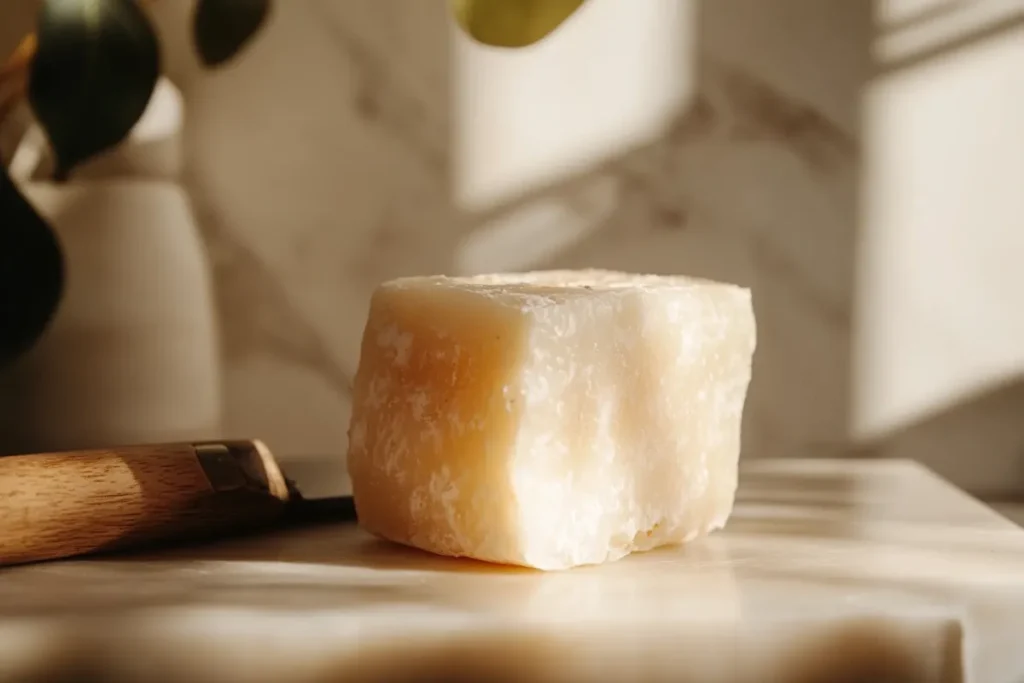Is it safe to cook with Parmesan rind? In this article, we’ll explore its safety, the best ways to use it, and how to maximize its rich flavor. From soups to sauces, learn how to make the most of every bit of your Parmesan while keeping your dishes both delicious and safe.
Understanding Parmesan Rind

Before discussing safety, it’s important to understand what Parmesan rind is. It’s the hard outer layer of the cheese wheel. Accordingly, it’s a natural byproduct of the cheese making process. Therefore, it develops during aging. This section explores the composition of the rind. Furthermore, we will discuss why it adds flavor. Consequently, understanding these aspects is essential for its safe use.
What is Parmesan Rind Made Of?
Parmesan rind is primarily composed of hardened cheese. It contains proteins, fats, and a low amount of moisture. Additionally, it may also have natural molds. These molds help with the ripening process. Moreover, the rind’s texture is much harder. Thus, it’s different from the cheese itself. The hardening occurs over time. Specifically, the rind undergoes dehydration during the aging phase.
The Flavor Profile of the Rind
The rind carries a concentrated flavor. Consequently, this flavor is due to the long aging process. Therefore, it has a very savory and umami taste. In addition, it will add a nutty and slightly salty note. Many cooks use it to boost the flavor of various dishes. For example, it enhances stocks and soups. In particular, its intense flavor comes from the proteins breaking down.
Is it Safe to Cook with Parmesan Rind?
The question, is it safe to cook with Parmesan rind, is a common concern. Generally, the answer is yes, it is safe when used correctly. However, there are some things to be aware of. This section will address these concerns. Thus, you will be able to use it safely. Therefore, informed usage will minimize risk.
Food Safety Considerations
Parmesan rind, like any food item, must be handled properly. Therefore, check the rind for any visible signs of spoilage. This includes unusual colors or smells. Moreover, proper storage is essential. Additionally, avoid using rinds that have been in contact with unhygienic surfaces. Finally, when in doubt, it’s better to discard it. In short, use your common sense to avoid any risks.
The Cooking Process and Safety
The cooking process helps to make Parmesan rind safe. High heat kills most harmful bacteria. Consequently, when added to soups or stocks, it is typically simmered. This process helps to break down the rind. As a result, the flavor is released. Therefore, ensure it is cooked thoroughly. For instance, simmering for at least 30 minutes is usually adequate.
How to Use Parmesan Rind Safely
Knowing how to safely use Parmesan rind is key. The right preparation and cooking methods can reduce any risk. This section will give you the best practices. Following these steps helps in using Parmesan rind safely. Moreover, following these guidelines will enhance your cooking.
Preparing the Rind for Cooking
First, rinse the rind under cold water. Afterward, scrub it with a brush to remove any dirt. Therefore, pat it dry before using. Additionally, you may want to cut off any very hard or discolored pieces. Finally, it’s important to remove any packaging materials. In addition, a clean rind will provide a cleaner flavor profile to the dish.
Cooking Methods with Parmesan Rind
Parmesan rind is great for adding flavor to soups, stocks, and sauces. Simply add it to the liquid during the simmering process. Therefore, it will infuse the dish with its flavor. Remember to remove it before serving. As a result, the flavors will meld into the dish. Specifically, allow the rind enough time to release its flavors fully.
Removing the Rind after Cooking
It’s important to always remove the Parmesan rind before serving. The rind is not meant to be eaten. Therefore, it can be tough and difficult to chew. Use a slotted spoon or strainer. This makes the removal process easy. Thus, your dishes will have great flavor and a good texture. Accordingly, check all servings to ensure no one eats a piece.
Benefits of Cooking with Parmesan Rind
Using Parmesan rind in cooking offers many advantages. It’s a good way to reduce food waste. Furthermore, it adds great flavor to your dishes. This section will highlight some key benefits of cooking with Parmesan rind. Thus, you’ll see why it’s a smart choice. Therefore, adding a culinary value to an item you would otherwise discard is always a plus.
Reducing Food Waste
Using the rind reduces waste. Instead of throwing it away, you’re extracting flavor. Therefore, this is a good approach to using the whole cheese. This will not only save you money but is also more responsible. Consequently, using the whole product makes culinary sense. In addition, this practice aligns with mindful cooking.
Enhancing Flavor
The main advantage is the added flavor. Parmesan rind offers a deep, savory taste. This improves the overall flavor of your dishes. For example, soups will become more complex. As a result, you’ll have restaurant quality meals. Specifically, this added layer of flavor can elevate the entire cooking experience.
Adding Depth to Dishes
Parmesan rind doesn’t just add saltiness. It enhances the depth of flavors. Therefore, dishes will taste more well-rounded. Additionally, it adds an umami note that is very satisfying. This is a simple trick to elevate your cooking. Namely, the richness it provides is hard to replicate with other ingredients.
Different Dishes to Use Parmesan Rind In
Parmesan rind is versatile. Thus, it can be used in many different kinds of dishes. It is particularly useful in recipes that call for long simmering times. This section will give you some practical ideas. These examples should help you use your rind creatively. Moreover, trying these ideas will encourage experimentation.
Adding Rind to Soups and Stocks

Soups and stocks are ideal for Parmesan rinds. They benefit from the deep flavor. Add it to the pot at the beginning. Then, allow it to simmer along with other ingredients. Remember to remove it before serving. As a result, the broth will be richer and more flavorful. This practice is especially useful for bone broths.
Using the Rind in Pasta Sauces
Parmesan rind can also add flavor to pasta sauces. Add it while the sauce is simmering. Moreover, it will infuse the sauce with a cheesy note. Remove it before adding the pasta. Specifically, it’s a great addition to tomato-based sauces. Additionally, try it with cream-based sauces for an extra touch.
Incorporating Rind in Braises
Braised dishes also benefit from Parmesan rind. Therefore, add the rind while the meat is cooking. As a result, it will add depth and richness. This works especially well with slow-cooked meals. Specifically, beef and pork braises work particularly well with Parmesan.
Is It Safe to Cook With Parmesan Rind? Safety Concerns Explained
Let’s delve deeper into the safety concerns around using Parmesan rind. While generally safe, it’s important to address specific questions. This section will look closely at any potential risks. This can ensure that you use Parmesan rind safely. Therefore, a thorough approach will eliminate most potential issues.
Addressing Concerns About Mold
Some people worry about the molds on the Parmesan rind. These molds are usually harmless. They are part of the natural cheese-making process. However, remove any visibly moldy spots. Thus, you can avoid any possible issues. Always use good judgement when it comes to food. Namely, it’s best to be safe rather than sorry.
Potential for Bacterial Contamination
Like any food, there’s a potential for bacterial contamination. Therefore, ensure that the rind is stored correctly. Also, cooking it thoroughly helps to kill most bacteria. Follow basic food safety guidelines. As a result, this will minimize risk. Specifically, keeping your work area clean is very important.
Allergic Reactions and Intolerances
If you have a dairy intolerance or allergy, be cautious. Parmesan rind still contains milk proteins. Therefore, these may cause a reaction. It’s always best to err on the side of caution. If you have doubts, it’s best to avoid it. In addition, look for dairy-free recipes as alternatives.
Storing Parmesan Rind Properly
Proper storage is very important. It helps keep the Parmesan rind safe and flavorful. This section will discuss best storage practices. Follow these guidelines to ensure your rind stays in good shape. Therefore, proper methods will maintain its quality.
Storing in the Refrigerator
The best place to store Parmesan rind is in the refrigerator. First, wrap it tightly in plastic or place it in an airtight container. This will prevent it from drying out. Furthermore, it will prevent the transfer of odors. In addition, place it in the coldest part of the fridge. Specifically, the vegetable drawer is usually the best spot.
Storing in the Freezer
For longer-term storage, freeze the Parmesan rind. Place it in a freezer-safe bag or container. Therefore, it will maintain its quality for several months. When you’re ready to use it, add it directly to the pot. No need to thaw first. Namely, freezing will significantly prolong its lifespan.
Checking for Spoilage
Before using stored Parmesan rind, always check for spoilage. Look for any signs of mold. Additionally, check for bad odors. If any of those are present, then discard it immediately. Always prioritize food safety over saving some food. This practice will ensure your food is safe to consume.
How to Select Quality Parmesan
Selecting good quality Parmesan cheese will also contribute to a better rind. Therefore, understanding what to look for is key. This section offers some pointers to help you buy the best. This can make a difference in your cooking. In addition, using quality cheese will provide a superior flavor.
Looking for DOP Designation
Look for the DOP (Denominazione di Origine Protetta) seal. This means it’s a certified authentic Parmesan cheese. Therefore, the quality is higher. Also, it means it is made in a specific region in Italy. Namely, this guarantees that the product has been made traditionally.
Checking the Color and Texture
Good Parmesan has a golden yellow color. The texture should be firm and hard. Avoid cheeses with cracks or dark spots. Therefore, these can be a sign of age or poor storage. Additionally, ask to try a sample before buying a large portion. Specifically, the taste should also be rich and nutty.
Buying a Whole Piece vs. Grated Cheese
Buy a whole piece of Parmesan whenever possible. Therefore, it will taste better and the rind will be of better quality. Grated cheese may not be as fresh. Furthermore, it will lack the flavor and complexity of a whole piece. In particular, pre-grated cheese may also include additives.
Innovative Uses for Parmesan Rind
Beyond the traditional methods, there are some creative ways to use Parmesan rind. These techniques can bring out new dimensions in your cooking. This section will offer some inspiration. Therefore, feel free to experiment with these ideas.
Making Parmesan Broth
Create a Parmesan broth by simmering the rind in water. Add some vegetables and herbs. This broth can be used in soups and risottos. It provides an extra boost of flavor. Additionally, this method uses the rind fully.
Infusing Oils with the Rind
Infuse olive oil with the Parmesan rind. Place the rind in a jar of oil. Allow it to infuse for a few days. Use the infused oil to drizzle on salads or pasta. It provides a subtle cheesy flavor. Specifically, use good quality olive oil for the best result.
Using Rind in Bread Baking
You can also add finely grated Parmesan rind to bread dough. It will add flavor and a slight cheesy note. Moreover, it enhances the overall aroma of the baked bread. Try this with various bread recipes. You might discover a new favorite.
Alternatives to Using Parmesan Rind
If you’re not sure about using Parmesan rind, there are other options. These alternatives can still add depth of flavor to your dishes. This section will look at some popular choices. You can use these when you don’t want to use rind. Consequently, it’s important to find flavors that you will enjoy.
Using Other Cheeses
Other hard cheeses, like Pecorino Romano, can be used similarly. They offer a salty and savory flavor. However, they may have slightly different flavor profiles. So, adjust accordingly based on the recipe. Notably, Pecorino has a more pronounced flavor.
Adding Dried Mushrooms
Dried mushrooms can add umami flavor. Therefore, they can mimic the effect of Parmesan rind. Also, they will add depth and richness. Rehydrate them before use. Thus, this will release the flavors. For example, porcini mushrooms work well in similar applications.
Using Nutritional Yeast
Nutritional yeast is a vegan option. It adds a cheesy and savory note. Therefore, this is good for those who can’t eat dairy. It can replicate some of the qualities of cheese in your dishes. So, consider this if you’re limiting dairy. In addition, it also provides a good source of B vitamins.
Conclusion: Is It Safe to Cook with Parmesan Rind?
In conclusion, is it safe to cook with Parmesan rind? Yes, generally it is safe. However, use it correctly. Always wash it well and cook it thoroughly. Furthermore, be mindful of storage and any signs of spoilage. Parmesan rind is a great way to enhance the flavors. Therefore, it’s an excellent addition to many recipes. With these guidelines, you can enjoy cooking with it safely and efficiently. In addition, you can be more conscious of food sourcing and waste.

